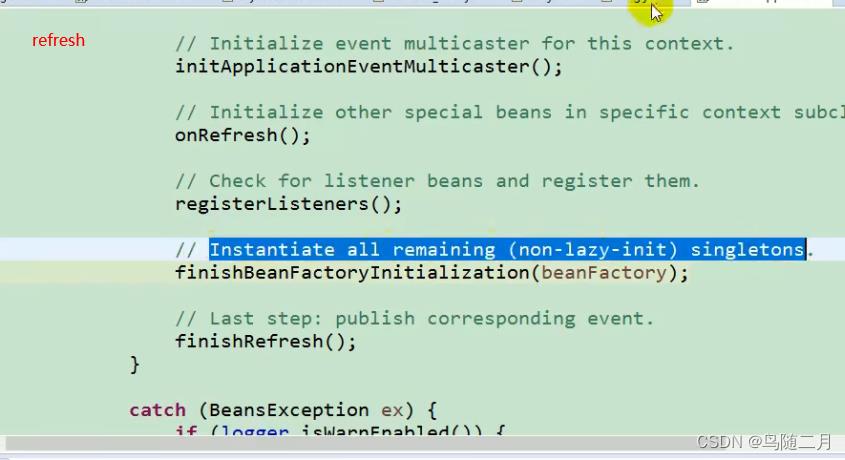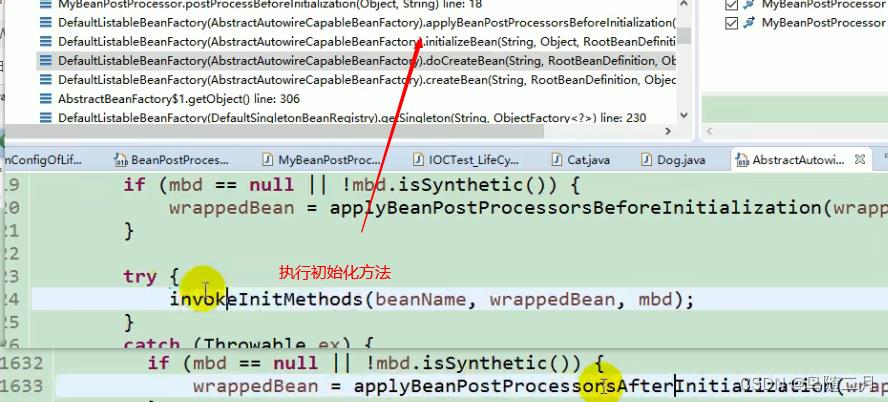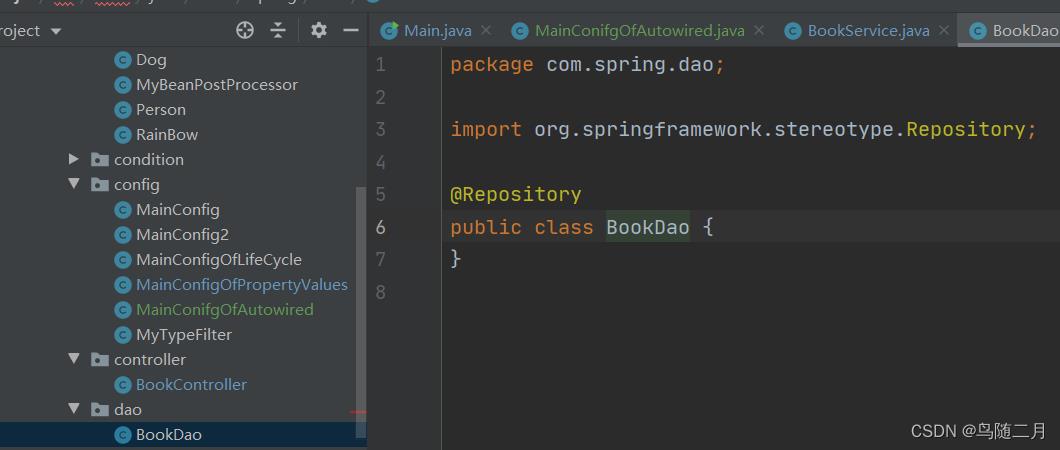spring注解(属性赋值自动装配)
Posted 月屯
tags:
篇首语:本文由小常识网(cha138.com)小编为大家整理,主要介绍了spring注解(属性赋值自动装配)相关的知识,希望对你有一定的参考价值。
目录标题
生命周期
指定初始化和销毁方法
之前在src\\main\\resources\\beans.xml配置文件中

现在
新建一个bean car

第一种 @Bean(initMethod=“init”,destroyMethod=“detory”)
package com.spring.bean;
import org.springframework.stereotype.Component;
@Component
public class Car
public Car()
System.out.println("car constructor...");
public void init()
System.out.println("car ... init...");
public void detory()
System.out.println("car ... detory...");
新建一个配置类
package com.spring.config;
import org.springframework.context.ApplicationListener;
import org.springframework.context.annotation.Bean;
import org.springframework.context.annotation.ComponentScan;
import org.springframework.context.annotation.Configuration;
import org.springframework.context.annotation.Scope;
import com.spring.bean.Car;
/**
* bean的生命周期:
* bean创建---初始化----销毁的过程
* 容器管理bean的生命周期;
* 我们可以自定义初始化和销毁方法;容器在bean进行到当前生命周期的时候来调用我们自定义的初始化和销毁方法
*
* 构造(对象创建)
* 单实例:在容器启动的时候创建对象
* 多实例:在每次获取的时候创建对象\\
*
* BeanPostProcessor.postProcessBeforeInitialization
* 初始化:
* 对象创建完成,并赋值好,调用初始化方法。。。
* BeanPostProcessor.postProcessAfterInitialization
* 销毁:
* 单实例:容器关闭的时候
* 多实例:容器不会管理这个bean;容器不会调用销毁方法;
*
*
* 遍历得到容器中所有的BeanPostProcessor;挨个执行beforeInitialization,
* 一但返回null,跳出for循环,不会执行后面的BeanPostProcessor.postProcessorsBeforeInitialization
*
* BeanPostProcessor原理
* populateBean(beanName, mbd, instanceWrapper);给bean进行属性赋值
* initializeBean
*
* applyBeanPostProcessorsBeforeInitialization(wrappedBean, beanName);
* invokeInitMethods(beanName, wrappedBean, mbd);执行自定义初始化
* applyBeanPostProcessorsAfterInitialization(wrappedBean, beanName);
*
*
*
*
* 1)、指定初始化和销毁方法;
* 通过@Bean指定init-method和destroy-method;
* 2)、通过让Bean实现InitializingBean(定义初始化逻辑),
* DisposableBean(定义销毁逻辑);
* 3)、可以使用JSR250;
* @PostConstruct:在bean创建完成并且属性赋值完成;来执行初始化方法
* @PreDestroy:在容器销毁bean之前通知我们进行清理工作
* 4)、BeanPostProcessor【interface】:bean的后置处理器;
* 在bean初始化前后进行一些处理工作;
* postProcessBeforeInitialization:在初始化之前工作
* postProcessAfterInitialization:在初始化之后工作
*
* Spring底层对 BeanPostProcessor 的使用;
* bean赋值,注入其他组件,@Autowired,生命周期注解功能,@Async,xxx BeanPostProcessor;
*
* @author lfy
*
*/
@ComponentScan("com.spring.bean")
@Configuration
public class MainConfigOfLifeCycle
//@Scope("prototype")
@Bean(initMethod="init",destroyMethod="detory")
public Car car()
return new Car();
测试

第二种 InitializingBean,DisposableBean
新建一个bean

package com.spring.bean;
import org.springframework.beans.factory.DisposableBean;
import org.springframework.beans.factory.InitializingBean;
import org.springframework.stereotype.Component;
@Component
public class Cat implements InitializingBean,DisposableBean
public Cat()
System.out.println("cat constructor...");
@Override
public void destroy() throws Exception
// TODO Auto-generated method stub
System.out.println("cat...destroy...");
@Override
public void afterPropertiesSet() throws Exception
// TODO Auto-generated method stub
//初始化
System.out.println("cat...afterPropertiesSet...");
修改配置类src\\main\\java\\com\\spring\\config\\MainConfigOfLifeCycle.java类名前
@ComponentScan("com.spring.bean")
测试

第三种 @PostConstruct @PreDestroy
新建bean

package com.spring.bean;
import javax.annotation.PostConstruct;
import javax.annotation.PreDestroy;
import org.springframework.beans.BeansException;
import org.springframework.beans.factory.annotation.Autowired;
import org.springframework.context.ApplicationContext;
import org.springframework.context.ApplicationContextAware;
import org.springframework.stereotype.Component;
@Component
public class Dog
public Dog()
System.out.println("dog constructor...");
//对象创建并赋值之后调用
@PostConstruct
public void init()
System.out.println("Dog....@PostConstruct...");
//容器移除对象之前
@PreDestroy
public void detory()
System.out.println("Dog....@PreDestroy...");
配置类不用修改
src\\main\\java\\com\\spring\\config\\MainConfigOfLifeCycle.java
测试

第四种 BeanPostProcessor后置处理器
添加后置处理器

package com.spring.bean;
import org.springframework.beans.BeansException;
import org.springframework.beans.factory.config.BeanPostProcessor;
import org.springframework.stereotype.Component;
/**
* 后置处理器:初始化前后进行处理工作
* 将后置处理器加入到容器中
* @author lfy
*/
@Component
public class MyBeanPostProcessor implements BeanPostProcessor
@Override
public Object postProcessBeforeInitialization(Object bean, String beanName) throws BeansException
// TODO Auto-generated method stub
System.out.println("postProcessBeforeInitialization..."+beanName+"=>"+bean);
return bean;
@Override
public Object postProcessAfterInitialization(Object bean, String beanName) throws BeansException
// TODO Auto-generated method stub
System.out.println("postProcessAfterInitialization..."+beanName+"=>"+bean);
return bean;
测试

原理











populateBean为各种属性赋值


底层使用

1.注入IOC容器
修改src\\main\\java\\com\\spring\\bean\\Dog.java
package com.atguigu.bean;
import javax.annotation.PostConstruct;
import javax.annotation.PreDestroy;
import org.springframework.beans.BeansException;
import org.springframework.beans.factory.annotation.Autowired;
import org.springframework.context.ApplicationContext;
import org.springframework.context.ApplicationContextAware;
import org.springframework.stereotype.Component;
@Component
public class Dog implements ApplicationContextAware
//@Autowired
private ApplicationContext applicationContext;
public Dog()
System.out.println("dog constructor...");
//对象创建并赋值之后调用
@PostConstruct
public void init()
System.out.println("Dog....@PostConstruct...");
//容器移除对象之前
@PreDestroy
public void detory()
System.out.println("Dog....@PreDestroy...");
@Override
public void setApplicationContext(ApplicationContext applicationContext) throws BeansException
// TODO Auto-generated method stub
this.applicationContext = applicationContext;
2.数据校验
3.处理 @PostConstruct @PreDestroy注解
处理Autowired注解
属性赋值
新建配置类

package com.spring.config;
import org.springframework.context.annotation.Bean;
import org.springframework.context.annotation.Configuration;
import org.springframework.context.annotation.PropertySource;
import com.spring.bean.Person;
@Configuration
public class MainConfigOfPropertyValues
@Bean
public Person person()
return new Person();
新建配置文件

之前赋值

现在
修改配置类src\\main\\java\\com\\spring\\config\\MainConfigOfPropertyValues.java

修改bean src\\main\\java\\com\\spring\\bean\\Person.java
package com.spring.bean;
import org.springframework.beans.factory.annotation.Value;
public class Person
//使用@Value赋值;
//1、基本数值
//2、可以写SpEL; #
//3、可以写$;取出配置文件【properties】中的值(在运行环境变量里面的值)
@Value("张三")
private String name;
@Value("#20-2")
private Integer age;
@Value("$person.nickName")
private String nickName;
public String getNickName()
return nickName;
public void setNickName(String nickName)
this.nickName = nickName;
public String getName()
return name;
public void setName(String name)
this.name = name;
public Integer getAge()
return age;
public void setAge(Integer age)
this.age = age;
public Person(String name, Integer age)
super();
this.name = name;
this.age = age;
public Person()
super();
// TODO Auto-generated constructor stub
@Override
public String toString()
return "Person [name=" + name + ", age=" + age + ", nickName=" + nickName + "]";
测试
AnnotationConfigApplicationContext applicationContext =
new AnnotationConfigApplicationContext(MainConfigOfPropertyValues.class);
printBeans(applicationContext);
System.out.println("=============");
Person person = (Person) applicationContext.getBean("person");
System.out.println(person);
ConfigurableEnvironment environment = applicationContext.getEnvironment();
String property = environment.getProperty("person.nickName");
System.out.println(property);
applicationContext.close();
private static void printBeans(AnnotationConfigApplicationContext applicationContext)
String[] definitionNames = applicationContext.getBeanDefinitionNames();
for (String name : definitionNames)
System.out.println(name);
自动装配
修改



新建配置类

package com.spring.config;
import org.springframework.beans.factory.annotation.Autowired;
import org.springframework.beans.factory.annotation.Qualifier;
import org.springframework.context.annotation.Bean;
import org.springframework.context.annotation.ComponentScan;
import org.springframework.context.annotation.Configuration;
import org.springframework.context.annotation.Primary;
import com.spring.bean.Car;
import com.spring.bean.Color;
import com.spring.dao.BookDao;
/**
* 自动装配;
* Spring利用依赖注入(DI),完成对IOC容器中中各个组件的依赖关系赋值;
*
* 1)、@Autowired:自动注入:
* 1)、默认优先按照类型去容器中找对应的组件:applicationContext.getBean(BookDao.class);找到就赋值
* 2)、如果找到多个相同类型的组件,再将属性的名称作为组件的id去容器中查找
* applicationContext.getBean("bookDao")
* 3)、@Qualifier("bookDao"):使用@Qualifier指定需要装配的组件的id,而不是使用属性名
* 4)、自动装配默认一定要将属性赋值好,没有就会报错;
* 可以使用@Autowired(required=false);
* 5)、@Primary:让Spring进行自动装配的时候,默认使用首选的bean;
* 也可以继续使用@Qualifier指定需要装配的bean的名字
* BookService
* @Autowired
* BookDao bookDao;
*
*
* 2)、Spring还支持使用@Resource(JSR250)和@Inject(JSR330)[java规范的注解]
* @Resource:
* 可以和@Autowired一样实现自动装配功能;默认是按照组件名称进行装配的;
* 没有能支持@Primary功能没有支持@Autowired(reqiured=false);
* @Inject:
* 需要导入javax.inject的包,和Autowired的功能一样。没有required=false的功能;
* @Autowired:Spring定义的; @Resource、@Inject都是java规范
*
* AutowiredAnnotationBeanPostProcessor:解析完成自动装配功能;
*
* 3)、 @Autowired:构造器,参数,方法,属性;都是从容器中获取参数组件的值
* 1)、[标注在方法位置]:@Bean+方法参数;参数从容器中获取;默认不写@Autowired效果是一样的;都能自动装配
* 2)、[标在构造器上]:如果组件只有一个有参构造器,这个有参构造器的@Autowired可以省略,参数位置的组件还是可以自动从容器中获取
* 3)、放在参数位置:
*
* 4)、自定义组件想要使用Spring容器底层的一些组件(ApplicationContext,BeanFactory,xxx);
* 自定义组件实现xxxAware;在创建对象的时候,会调用接口规定的方法注入相关组件;Aware;
* 把Spring底层一些组件注入到自定义的Bean中;
* xxxAware:功能使用xxxProcessor;
* ApplicationContextAware==》ApplicationContextAwareProcessor;
*
*
* @author lfy
*
*/
@Configuration
@ComponentScan("com.spring.service","com.spring.dao",
"com.spring.controller","com.spring.bean")
public class MainConifgOfAutowired
测试

@Qualifier、@Autowired(required=false)@Primary
修改

package com.spring.dao;
import org.springframework.stereotype.Repository;
//名字默认是类名首字母小写
@Repository
public class BookDao
private String lable = "1";
public String getLable()
return lable;
public void setLable(String lable)
this.lable = lable;
@Override
public String toString()
return "BookDao [lable=" + lable + "]";

package com.spring.service;
import javax.annotation.Resource;
import org.springframework.beans.factory.annotation.Autowired;
import org.springframework.beans.factory.annotation.Qualifier;
import org.springframework.stereotype.Service;
import com.spring.dao.BookDao;
@Service
public class BookService
//@Qualifier("bookDao")
//按照名字注册
@Autowired(required=false)
//有则注册,无则不注册
//@Autowired
private BookDao bookDao;
public void print()
System.out.prin以上是关于spring注解(属性赋值自动装配)的主要内容,如果未能解决你的问题,请参考以下文章